

| Venue |
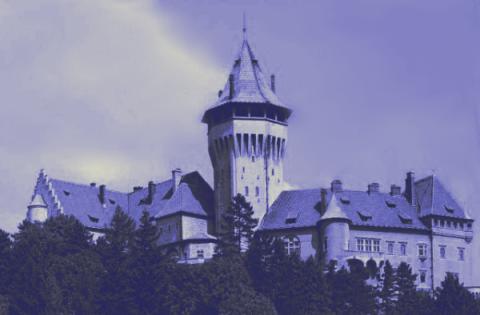
| SIROCCO 2004 will take place in the Smolenice Castle in Slovakia located about 35km from Bratislava. The castle, surrounded by a beautiful park, is towering above the village of Smolenice in the eastern foothills of Male Karpaty (Small Carpatians). Destroyed in the late 18th century and rebuilt in the Romantic style, the castle now offers accomodation in a tranquil and romantic atmosphere. |
Perhaps
the most valuable archaeological discovery made
in the Low Carpathians is that of an ancient settlement at
Molpir, dating from the younger Hallstatt era
(second half of the 7th century B. C.). The fortified settlement
covers the surface of almost 12 to 14
hectares. Its mission was to demonstrate the power of the
chieftain and of the nobility and, in times of danger, to
protect the neighbouring population and its possessions from
enemies.
The settlement was abandoned in the middle of the sixth
century B. C.
The
construction of the present Smolenice Castle was
undertaken on the ruins of the ancient castle in 1854 and
the actual construction of the main castle building started
as late as in 1911 by Jozef Palffy Jr., the landlord of Smolenice and Dobrá Voda estates.
A
Apart
from its attractive interior, the guests apreciate green lawns of the
courtyards animated by flowerbeds and castle surroundings
featuring a well-kept English park, small lake and amphitheatre.
 Situated on
eastern foothills of Male Karpaty (Small Carpatians) mountains
where the widely spreading ridge of the mountains begins to
take up altitude with its highest peaks, the region of today's willage Smolenice
has been permanently settled since the Stone Age.
History and modern archeological finds give evidence of the fact
that the nearby mountain pass used to serve one of major roads
connecting the north of Europe with the south - a branch of
the Amber Road leading from the Baltic down to the
Mediterranean region. In Middle Ages when the boundary
between the kingdoms of Hungary and of Bohemia was
constituted first by the ridge of Low Carpathians and later
by the river Morava, the commercial and military Bohemian
Road led through the pass.
Situated on
eastern foothills of Male Karpaty (Small Carpatians) mountains
where the widely spreading ridge of the mountains begins to
take up altitude with its highest peaks, the region of today's willage Smolenice
has been permanently settled since the Stone Age.
History and modern archeological finds give evidence of the fact
that the nearby mountain pass used to serve one of major roads
connecting the north of Europe with the south - a branch of
the Amber Road leading from the Baltic down to the
Mediterranean region. In Middle Ages when the boundary
between the kingdoms of Hungary and of Bohemia was
constituted first by the ridge of Low Carpathians and later
by the river Morava, the commercial and military Bohemian
Road led through the pass.
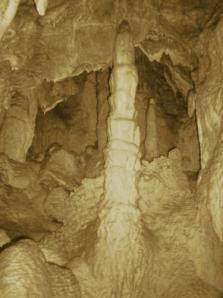 Nature
endowed this region
with countless riches. Apart from pictoresque hills flanked with
rich vineyards and orchards, colorful cereal fields and deep forests,
it is here where the unique Smolenice Karst is located.
The Smolenice Karst, formed by relatively pure Jurassic Limestones,
differs from the other Slovak karst regions mainly to be found in Triassic Limestones.
The only Slovak cave originated as a result of cleavage - Driny Cave is also located
here.
Nature
endowed this region
with countless riches. Apart from pictoresque hills flanked with
rich vineyards and orchards, colorful cereal fields and deep forests,
it is here where the unique Smolenice Karst is located.
The Smolenice Karst, formed by relatively pure Jurassic Limestones,
differs from the other Slovak karst regions mainly to be found in Triassic Limestones.
The only Slovak cave originated as a result of cleavage - Driny Cave is also located
here.
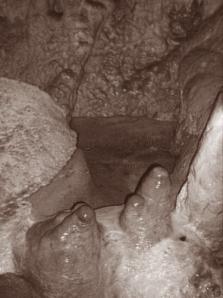 The Driny Cave is
a fissure cave formed by the dissolving and erosive action of rainwater that had penetrated into
the underground system of cracks and fissures, whilst in the other Slovak caves the subterranean
passages were carved out by underground rivers. Its
passages are not very extensive but they are just as interesting as they are filled with the most
beautiful speleothems imaginable. The dripstone formation covers a whole range of colours from
yellow to dark brown and takes the form of hanging draperies with a characteristic indented lining.
Of no less interest are the frozen waterfalls and botryoidal decorations preserved at the bottom of
former subterranean lakes.
The entrance lies at an
altitude of 393 m and was discovered in 1929 by local villagers,
the Weisabl and Valovec brothers and J Vanic. They were assisted by S Vanic
who, co-incidentally, invented a parachute.
The Driny Cave is
a fissure cave formed by the dissolving and erosive action of rainwater that had penetrated into
the underground system of cracks and fissures, whilst in the other Slovak caves the subterranean
passages were carved out by underground rivers. Its
passages are not very extensive but they are just as interesting as they are filled with the most
beautiful speleothems imaginable. The dripstone formation covers a whole range of colours from
yellow to dark brown and takes the form of hanging draperies with a characteristic indented lining.
Of no less interest are the frozen waterfalls and botryoidal decorations preserved at the bottom of
former subterranean lakes.
The entrance lies at an
altitude of 393 m and was discovered in 1929 by local villagers,
the Weisabl and Valovec brothers and J Vanic. They were assisted by S Vanic
who, co-incidentally, invented a parachute.
 First
written records about the densely populated
settlement of Smolenice date back to the 13th century as
suggested by the charter issued by Bela IV in 1256. It
mentions, for the first time, Smolenice under the name of
"villa solmus" in connection with the frontier guards on the
Bohemian Road. According to a mention in the
1336 king's charter, the nearby Bukova was a custom-station
on this road.
Hungarian kings from the House of Arpad already in the 12 th century appointed
military garrisons to guard both sides of the range and
built a network of strong fortified castles for their
protection of which the closest to Smolenice are Ostry
Kamen, Korlatko and Plavecky Castle.
First
written records about the densely populated
settlement of Smolenice date back to the 13th century as
suggested by the charter issued by Bela IV in 1256. It
mentions, for the first time, Smolenice under the name of
"villa solmus" in connection with the frontier guards on the
Bohemian Road. According to a mention in the
1336 king's charter, the nearby Bukova was a custom-station
on this road.
Hungarian kings from the House of Arpad already in the 12 th century appointed
military garrisons to guard both sides of the range and
built a network of strong fortified castles for their
protection of which the closest to Smolenice are Ostry
Kamen, Korlatko and Plavecky Castle.
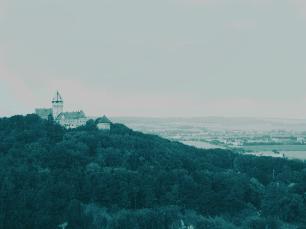 The
Smolenice castle was one of the youngest guarding
and protecting castles in the Low Carpathian Mountains.
At
the turn of the 15th and 16th centuries, Smolenice was
granted the status of a town.
Unfortunately, the town often suffered from adversities of
wars. Prokop the Great with his militant Hussites passed
through it in 1428. Nor did the Turkish raids and Hungarian
uprisings spare the town of Smolenice from suffering and
damages, even though the town and the late Renaissance
church from 1642 were protected during the attacks of the
Turks by solid fortified walls. And thus, in 1632, Smolenice
suffered the fate of many other towns and was raided by
fierce Turkish troops.
The inexorable history records that the castle
was conquered by the Kurutzes in 1705. Two years later,
however, these were chased away by the imperor's army.
The
Smolenice castle was one of the youngest guarding
and protecting castles in the Low Carpathian Mountains.
At
the turn of the 15th and 16th centuries, Smolenice was
granted the status of a town.
Unfortunately, the town often suffered from adversities of
wars. Prokop the Great with his militant Hussites passed
through it in 1428. Nor did the Turkish raids and Hungarian
uprisings spare the town of Smolenice from suffering and
damages, even though the town and the late Renaissance
church from 1642 were protected during the attacks of the
Turks by solid fortified walls. And thus, in 1632, Smolenice
suffered the fate of many other towns and was raided by
fierce Turkish troops.
The inexorable history records that the castle
was conquered by the Kurutzes in 1705. Two years later,
however, these were chased away by the imperor's army.
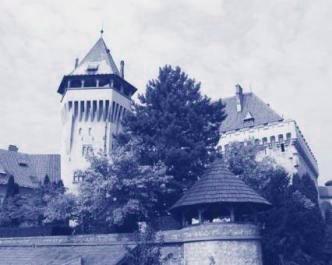 The
present Smolenice Castle is standing on the site of
a former Gothic fortified castle from the 15th century. In
the past, the castle was adapted in accordance with the
needs and preferences of its individual owners. In the 15th
century, it was in the possession of the Hungarian king
Sigismund of Luxembourg and played the role of a guarding
castle. Later, in the early 16th century, it was owned by
the House of Orszagh, toward the end of the 16th century it
The
present Smolenice Castle is standing on the site of
a former Gothic fortified castle from the 15th century. In
the past, the castle was adapted in accordance with the
needs and preferences of its individual owners. In the 15th
century, it was in the possession of the Hungarian king
Sigismund of Luxembourg and played the role of a guarding
castle. Later, in the early 16th century, it was owned by
the House of Orszagh, toward the end of the 16th century it
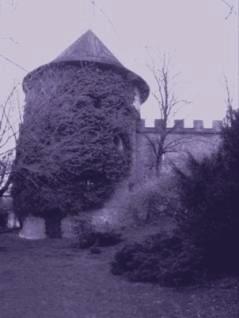 got into the hands of Erdody and Palffy families. Like other
castles, the Castle of Smolenice also suffered many turns of
fate. It is well known that in the beginning of the 18th
century it became the scene of fights between the Kurutz
rebels and emperor's army. During the Erdody rule, the
castle declined and its next owners, the House of Palffy,
abandoned the castle to its gloomy destiny. The last blow
was dealt by the Napoleonic wars when the castle burned down
and fell into ruins.
got into the hands of Erdody and Palffy families. Like other
castles, the Castle of Smolenice also suffered many turns of
fate. It is well known that in the beginning of the 18th
century it became the scene of fights between the Kurutz
rebels and emperor's army. During the Erdody rule, the
castle declined and its next owners, the House of Palffy,
abandoned the castle to its gloomy destiny. The last blow
was dealt by the Napoleonic wars when the castle burned down
and fell into ruins.
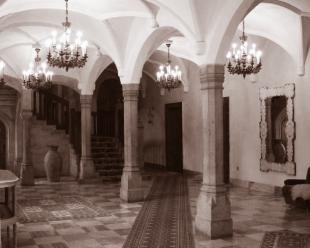 Under the influence of romanticist
ideas the builder drew inspiration from the architecture of
the castles of Central France. They did not hesitate
to pull down completely the original historical building
from which they preserved only the peripheral bastions.
Although the owner longed to see the construction
completed, his financial means were not ample enough to
materialize his idea in its completeness. The crude and only
partially inhabited building stood almost lifeless still
after the World War. It is probably only due to a
coincidence of propitious circumstances that this unfinished
structure, lacking in unity of style but nonetheless
interesting survived up to the aftermath of World War II.
Under the influence of romanticist
ideas the builder drew inspiration from the architecture of
the castles of Central France. They did not hesitate
to pull down completely the original historical building
from which they preserved only the peripheral bastions.
Although the owner longed to see the construction
completed, his financial means were not ample enough to
materialize his idea in its completeness. The crude and only
partially inhabited building stood almost lifeless still
after the World War. It is probably only due to a
coincidence of propitious circumstances that this unfinished
structure, lacking in unity of style but nonetheless
interesting survived up to the aftermath of World War II.
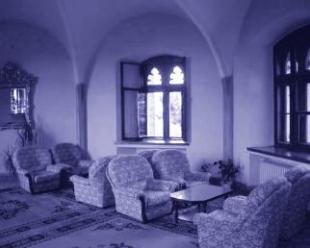 thorough reconstruction of the castle was undertaken
by the Slovak Academy of Sciences in 1955. The accommodation
capacity has been set to 100 beds, so as to take full
advantage of the castle premises without disturbing its
external appearance and environment. The Smolenice Castle
has not been granted the status of a cultural monument and
thorough reconstruction of the castle was undertaken
by the Slovak Academy of Sciences in 1955. The accommodation
capacity has been set to 100 beds, so as to take full
advantage of the castle premises without disturbing its
external appearance and environment. The Smolenice Castle
has not been granted the status of a cultural monument and
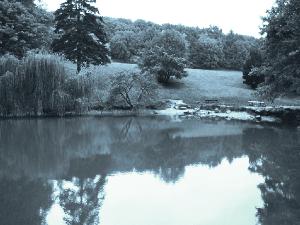 is not open to public visitors and sightseers. It serves
exclusively the Slovak Academy of Sciences as its
residential and working establishment.
is not open to public visitors and sightseers. It serves
exclusively the Slovak Academy of Sciences as its
residential and working establishment.